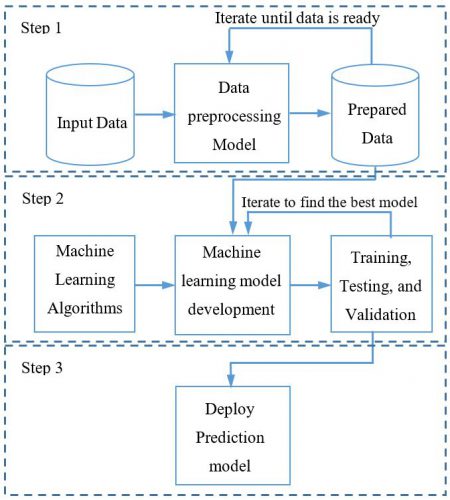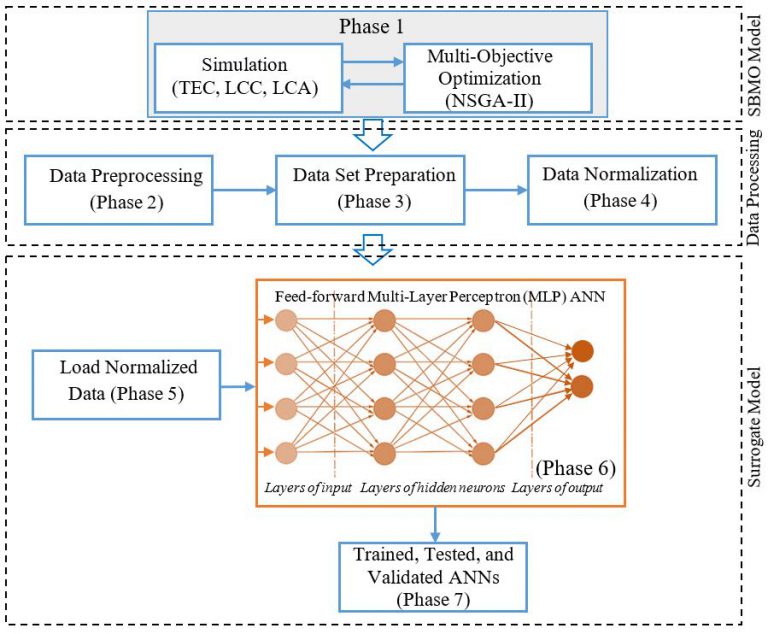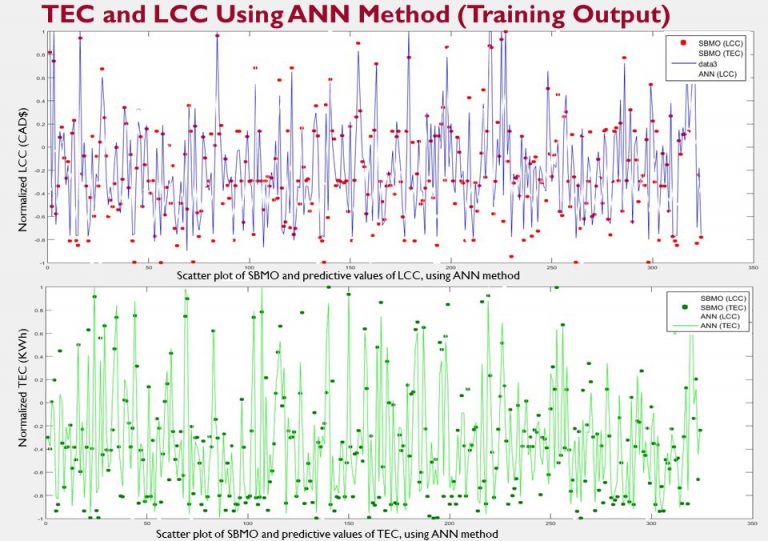Artificial Intelligence Integration in Energy Models
Our Novel Approach
The main idea and motivation behind Extergy’s approach relies on trying to bridge the gap between building Simulation-Based Multi-Objective Optimization (SBMO) and Artificial Neural Network (ANN). For a whole building simulation and optimization, current SBMOs often need thousands of simulation evaluations. Therefore, the optimization becomes unfeasible because of the computation time and complexity of the dependent parameters. To this end, one feasible technique to solve this problem is to implement surrogate models to computationally imitate expensive real building simulation models. The objective of our approach focuses on developing a robust ANN to explore vast and complex data generated from the SBMO model. More specifically, it aims to propose an accurate ANN to predict energy consumption using data from the SBMO model. The proposed model will potentially offer new venues to predict Total Energy Consumption (TEC), LCC, and Life Cycle Assessment (LCA) for different renovation scenarios, and select the optimum scenario.
New advancements in technologies relying on Artificial Neural Network (ANN) improve computational capabilities and the accuracy of models. Few studies have been conducted covering the integration of ANN and simulation or optimization. Also, the full integration between them, especially for building renovation, is still an open research problem. Besides, modeling and energy performance analysis using ANN for building renovation is not commonly used by decision-makers to perform comprehensive implementation, creating the need for a better energy analytical framework.
The integration of the simulation and optimization algorithms improves the energy performance of buildings through the selection of optimum scenarios and the fine-tuning of the desired renovation methods. For a large project, Simulation-Based Multi-Objective Optimization (SBMO) often needs hundreds or thousands of simulation evaluations for optimization. Nevertheless, to achieve reliable results, the energy performance of each renovation scenario should be calculated by implementing whole building simulation tools that consider the specific characteristics of the building over the study period. It is clear that this procedure also results in a prohibitive computational time, even for simple buildings, and sometimes becomes unfeasible due to the complexity of the dependent parameters. One feasible method to resolve this problem is to implement surrogate models to computationally mimic expensive, real building simulation models with a more feasible model.
Our engineers aims to develop a surrogate ANN for selecting near-optimal building energy renovation methods, considering energy consumption and LCA, while providing an efficient method to deal with the limited renovation budget. Different scenarios can be compared in a building renovation strategy to improve energy efficiency. Each scenario considers several methods, including the improvement of the building envelopes, Heating, Ventilation and Air-Conditioning (HVAC) and lighting systems. The ANNs were developed as the surrogate models for emulating computationally expensive real building simulation models with more feasible models. To demonstrate the applicability of the models, a case study is developed to evaluate the accuracy of proposed ANNs. The case study of different renovation methods for an institutional building that have been processed through the SBMO model, has been investigated. The findings of the study demonstrate that the proposed trained network can act as an accurate and quick model for optimizing the energy performance of buildings, considering LCC and LCA.

Surrogate models are among the most promising solutions to improve convergence speed in optimization problems, while maintaining accuracy, as they can reduce the function evaluation computation cost and smooth noisy response functions. A Machine Learning Model (MLM) is a surrogate model of the original simulation model. It usually imitates the behavior of the original simulation model to be able to produce the model responses at reduced computational times. Creating an MLM often involves the following three main steps: (1) Sampling input features as the data set, which creates a data set for training the surrogate model; (2) Applying a suitable MLM based on the data set, training and testing each model, and validating each MLM before using it as a ‘‘surrogate’’ of the original model; (3) deploying MLM as a prediction model.
In more detail, the first step includes data collection and processing, while the second step focuses on the MLMs development. During the second step, the processes of the selection and development of MLM, training, testing, and validation take place. The first and second steps may be iteratively repeated for the MLM until the convergence happens or validation achieves success. Finally, in the third step, the MLM can be utilized as a prediction model. The following figure describes the stepwise procedure of the methodology.

ANNs are a type of Artificial Intelligence modeling method that imitates the human brain’s behavior. ANNs efficiently emulate the complex relationships of biological networks to answer complex non-linear problems. By doing so, accurate results are maintained, while the computational time becomes insignificant. ANNs are pre-programmed in many tools, such as MATLAB®, and their efficiency is demonstrated in various building studies. Many research studies have been conducted considering ANN techniques for buildings. The literature shows that a significant number of previous MLM studies (47% out of 63 studies) have used ANN to predict building energy consumption. The learning process in ANN, called “network training”, is the ability to learn ‘‘rules’’ based on previous known relationships, and using them to control physical phenomenon and generalize results for new situations.
ANNs model the relationship between inputs and outputs by learning from the recorded data. Neurons are the fundamental computation units for ANN, which are connected by weighted links (synapses connections). Information transmission and manipulation occur using these networks. Input data from previous neurons is received by the following neurons. A transfer function is used to manage these data and combine them to generate output data that are sent to the neurons in the next layer. Each neuron has associated weight and bias, which makes the network learn from provided inputs and outputs using training techniques. This iterative procedure continues until a stopping criterion is achieved, that can be the maximum number of iterations defined as epochs or the goals that are obtained, which properly set the weights of the synaptic connections by minimizing certain factors, for example the Root Mean Squared Error (RMSE) or the Sum of Squared Errors (SSE). Using ANN has a high potential for improving energy consumption modeling, analysis, and long-term forecasts for industries. The advantages of using small data sets, while maintaining the high accuracy of forecasting for energy consumption analysis using different MLMs have been proven by several researchers.
ANN has been used in various research areas, including energy performance prediction, energy and cost optimization, and energy retrofitting. Several studies have been proposed to minimize energy consumption using ANN. One proposed a multi objective optimization (MOO) considering five decision variables, i.e. insulation material for roof and external wall, windows, HVAC systems, and solar collector types for building retrofitting and three objective functions, i.e. energy consumption, thermal discomfort hours, and overall investment cost. The energy consumption for lighting is excluded from their study. Consequently, a three layer feedforward NN with input, hidden, and output layers, was utilized to combine with the MOO to quantitatively evaluate the selection of different technologies for retrofitting of an existing school.
In our approach, different ANNs are used to predict and model energy performance, LCC, and environmental impacts of renovating combinations of members of an existing building, i.e. Roof Types (R), External Walls (EW), windows (W), Façade Type (FT), Window to Wall Ratio (WWR), HVAC systems, Cooling Operation Schedule (COS), Heating Operation Schedule (HOS), Lighting systems (Li), and External Window Open (EWO).

Extergy’s approach integrates the optimization power of SBMO with modeling capability of Multilayer Perceptron (MLP) ANN. The main advantage of this integration is to improve the computing time while achieving superior accuracy. The proposed framework has three essential but interdependent parts, which are SBMO model development, data preprocessing, and surrogate model development. Each parts has several phases that are explained in detail. The first phase is the main part of another research and are described therein.
It focuses on ANN to achieve a renovation scenario that minimizes energy consumption, LCC, and environmental impacts. Different ANNs are evaluated in this research. The complexity of the model has a significant effect on the training time and performance of the model on test data. Separate ANNs were used to model the relationship between the near optimal renovation scenarios of buildings envelope, HVAC, and lighting, and their TEC, LCC, and LCA. Furthermore, to evaluate the efficiency of the proposed model, a comparison between the SBMO and the final results of the ANN is performed to clarify the performance of the surrogate model.

In the pursuit of solving environmental and financial problems of existing buildings, the optimization of TEC, LCC, and LCA in the renovation of existing building envelopes, HVAC, and lighting has a significant impact. Therefore, it is important to have appropriate tools available for the renovation stage, to assist decision-makers in finding efficient scenarios. Extergy focuses on developing new and robust ANNs, for use as surrogate models for simulation, and coupling them with the proposed SBMO model to explore vast and complex data generated from our previous research.
In the first phase, the optimization process, coupled with the energy simulation tool, forecasts the building TEC, LCC, and LCA. The proposed ANNs can work as a building simulation tool to select the near-optimum renovation scenarios; thereby significantly decreasing computational time and effort.
The project was implemented based on the results of the SBMO. Different ANNs are generated in MATLAB® by using the outcomes of DesignBuilder energy simulations as targets for network training and testing. The process starts by preparing the SBMO model for the existing building and analyzing the results. The regressions between the ANN predictions and target SBMO outputs plots shows an acceptable agreement between the predictions and the SBMO, with regression coefficients close to 1. The ANNs provide satisfactory imitation of the SBMO, with the MSE for TEC vs LCC and TEC vs LCA of 0.016 and 0.056, respectively. Therefore, ANNs are acceptable to implement as surrogate models for simulation in SBMO to allow fast evaluations.



